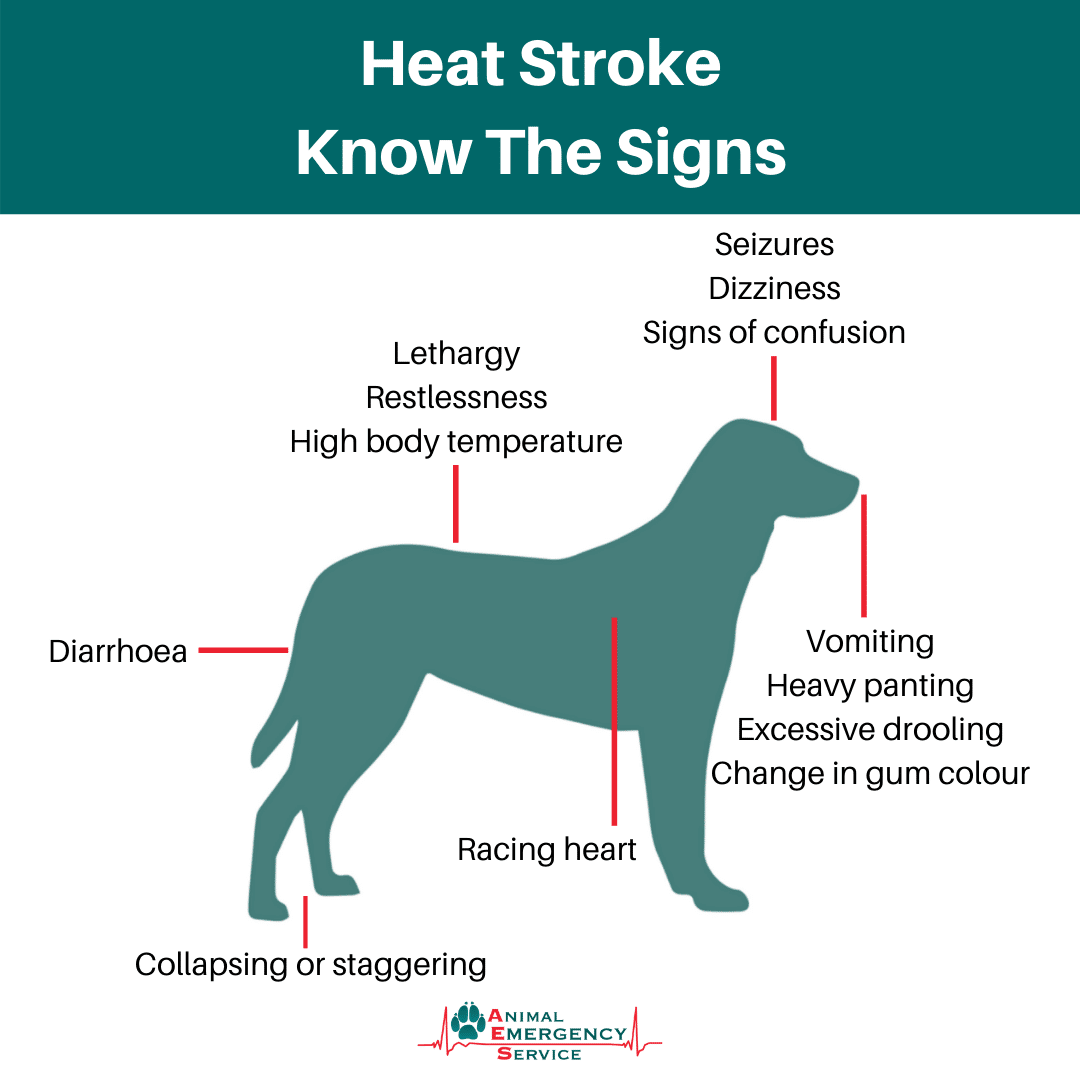Heat Exhaustion in Dogs is characterized by symptoms such as excessive panting, dehydration, excessive drooling, fever, and rapid pulse. If your dog is showing any of these signs, they may be experiencing heat exhaustion and require immediate attention and treatment.
Understanding Heat Exhaustion In Dogs
Understanding heat exhaustion in dogs is crucial to their well-being. Symptoms include excessive panting, dehydration, excessive drooling, fever, and muscle tremors. With prompt action and cooling measures, dogs can recover from heat exhaustion and avoid life-threatening heatstroke.
What Is Heat Exhaustion?
Heat exhaustion is a serious condition that occurs when a dog’s body temperature rises to dangerous levels due to excessive heat exposure. Dogs are highly susceptible to heat exhaustion because they have limited sweat glands and rely on panting to regulate their body temperature. When panting isn’t enough to cool them down, their body can overheat, leading to heat exhaustion.
Contributing Factors
Several factors can contribute to heat exhaustion in dogs:
- High temperatures and humidity
- Lack of shade or shelter
- Strenuous physical activity
- Thick coats or breeds with shortened airways
- Leaving a dog in a parked car
- Inadequate access to fresh water
Signs Of Heat Exhaustion
It’s important to be able to recognize the signs of heat exhaustion in your dog so that you can take immediate action to cool them down. Look out for the following symptoms:
- Excessive panting or difficulty breathing
- Dehydration
- Excessive drooling
- Fever
- Bright red, gray, purple, or bluish gums
- Lack of urine
- Rapid pulse
- Muscle tremors

Credit: autumntrailsvet.com
Detecting Heat Exhaustion In Dogs
Detecting heat exhaustion in dogs can be crucial for their well-being. Look out for signs like excessive panting, dehydration, excessive drooling, fever, discolored gums, lack of urine, rapid pulse, and muscle tremors. If your dog shows these symptoms, it’s important to take immediate action to cool them down and seek veterinary assistance to ensure their survival.
Excessive Panting Or Difficulty Breathing
One of the first signs of heat exhaustion in dogs is excessive panting or difficulty breathing. If you notice that your dog is panting constantly or faster than normal (hyperventilation), it could be a clear indication that they are overheated. Panting is a natural way for dogs to cool down, but if it becomes excessive or if they are struggling to catch their breath, it’s important to take immediate action.Dehydration
Dehydration is another common symptom of heat exhaustion in dogs. When dogs are exposed to high temperatures for too long, they can quickly become dehydrated. You can check if your dog is dehydrated by gently lifting the skin between their shoulder blades. If the skin doesn’t quickly return to its normal position, it could be a sign that they are dehydrated.Excessive Drooling
Excessive drooling is another sign that your dog may be suffering from heat exhaustion. Dogs regulate their body temperature by panting and drooling, but when they are overheated, they may drool more than usual. If you notice that your dog is drooling excessively, it’s important to address the situation immediately.Fever
A fever can be a warning sign of heat exhaustion in dogs. Elevated body temperature is a clear indicator that your dog’s body is struggling to cope with the intense heat. If your dog feels hotter than usual to the touch or if they are showing other signs of heat exhaustion, such as panting and drooling, it’s important to take their temperature and seek medical attention if necessary.Changes In Gum Color
Changes in gum color can indicate heat exhaustion in dogs. Normally, a dog’s gums should be a healthy pink color. However, when a dog is overheated, their gums may appear bright red, gray, purple, or bluish. These changes in gum color can be a sign of poor oxygen circulation and should be taken seriously.Lack Of Urine
If your dog is suffering from heat exhaustion, they may produce less urine than usual or even stop urinating altogether. This is because their body is conserving fluids due to dehydration. If you notice a significant decrease in your dog’s urination or if they are not urinating at all, it’s essential to address the situation promptly.Rapid Pulse
A rapid pulse is a clear sign that your dog’s body is working extra hard to cope with the heat. You can check your dog’s pulse by placing your hand on their chest, just behind their left elbow. If you feel a strong and rapid heartbeat, it’s an indication that your dog is suffering from heat exhaustion.Muscle Tremors
Muscle tremors can occur in dogs experiencing heat exhaustion. These tremors are involuntary movements of the muscles and can be a sign of the body’s struggle to regulate its temperature. If you notice your dog trembling or shaking uncontrollably, it’s crucial to cool them down and seek veterinary attention immediately. Remember, early detection is key when it comes to heat exhaustion in dogs. If you notice any of these signs or suspect that your dog may be overheating, it’s important to take immediate action to prevent further complications. Providing shade, fresh water, and a cool environment are essential steps in ensuring your dog’s well-being during hot weather.Treating Heat Exhaustion In Dogs
Heat exhaustion in dogs can be detected through symptoms such as excessive panting, dehydration, drooling, and rapid pulse. Immediate treatment is necessary to prevent heatstroke, which can be life-threatening. If you notice any of these signs, seek veterinary assistance and provide your dog with immediate cooling measures.
Providing Immediate Cooling
If you suspect your dog is experiencing heat exhaustion, it’s crucial to provide immediate cooling to lower their body temperature. This can be accomplished by:
- Bringing your dog to a shaded or air-conditioned area.
- Applying cool water to their body, especially the head, neck, and groin areas.
- Using wet towels or ice packs wrapped in a towel.
- Using a fan to help evaporate the water and cool down your dog.
Seeking Veterinary Help
While providing immediate cooling is essential, it’s equally important to seek veterinary help as soon as possible. Heat exhaustion can escalate into heat stroke, which can be life-threatening. Contact your veterinarian immediately for guidance and to schedule an appointment. They will be able to assess your dog’s condition and provide appropriate medical intervention if necessary.
Rehydration And Electrolyte Balance
One of the primary goals in treating heat exhaustion is to rehydrate your dog and restore their electrolyte balance. Your veterinarian may administer intravenous fluids to replenish lost fluids and electrolytes. In some cases, you may be advised to give your dog small amounts of water or an electrolyte solution orally. Always follow your veterinarian’s instructions and monitor your dog’s hydration levels closely.
During recovery, it’s essential to avoid overexertion or exposure to hot environments. Keep your dog in a cool, calm, and quiet area to allow them to rest and recuperate properly.
Note: It’s important to consult your veterinarian for specific guidance tailored to your dog’s individual needs and condition.
Monitoring For Complications
After initial treatment, it’s crucial to monitor your dog closely for any complications or worsening symptoms. Some potential complications of heat exhaustion include:
- Organ damage
- Heat stroke
- Dehydration
- Electrolyte imbalances
- Respiratory distress
- Irregular heart rhythm
If you notice any concerning signs or your dog’s condition doesn’t improve, contact your veterinarian immediately. Early detection and prompt treatment can make a significant difference in your dog’s recovery.

Credit: www.vets-now.com
Preventing Heat Exhaustion In Dogs
Heat exhaustion is a serious condition that can affect dogs, especially during hot weather. As responsible pet owners, it is crucial to take necessary measures to prevent heat exhaustion and ensure the well-being of our furry friends. Here are some effective ways to prevent heat exhaustion in dogs:
Avoiding Hot Environments
It is essential to keep your dog away from hot environments, especially during peak sun hours. Avoid exposing them to direct sunlight for extended periods, as this can quickly lead to heat exhaustion. Find shady areas where your dog can relax and cool down.
Providing Shade And Water
Always ensure that your dog has access to shade and plenty of fresh water. Set up a cool, sheltered spot in your yard where they can seek refuge from the heat. Consider placing a large umbrella, canopy, or a dog-friendly sunshade to provide extra shade.
Limiting Exercise During Hot Weather
During hot weather, it’s crucial to limit your dog’s exercise and outdoor activities. High-intensity exercise can increase their body temperature quickly, putting them at risk of heat exhaustion. Opt for shorter walks during cooler times of the day, such as early mornings or evenings.
Avoiding Leaving Dogs In Cars
Leaving dogs in cars, even for a short period, can be extremely dangerous and potentially life-threatening. The temperature inside a car can rise rapidly, even with the windows slightly open, leading to heatstroke or death. Never leave your dog unattended in a parked car, even if you think it’s just for a few minutes.
By following these preventative measures, you can significantly reduce the risk of heat exhaustion in dogs and ensure their safety and well-being during hot weather. Remember, your dog’s health and comfort should always be a top priority.
Breeds Prone To Heat Exhaustion
When it comes to heat exhaustion in dogs, certain breeds are more susceptible than others. These breeds are prone to overheating due to their physical characteristics and genetic predisposition. If you have a dog from one of these breeds, it’s important to be extra vigilant in the summer months and take necessary precautions to prevent heat exhaustion.
Pug
The Pug breed is well-known for its adorable squished face and compact size. However, these traits can make them more prone to heat exhaustion. Pugs have difficulty regulating their body temperature, and their short noses restrict airflow, making it harder for them to cool down. It’s crucial to provide them with plenty of shade, fresh water, and air conditioning to avoid overheating.
Bulldog
Bulldogs are another breed that is prone to heat exhaustion. Their stout bodies and short muzzles make it challenging for them to dissipate heat effectively. Bulldogs are also known to have a higher resting body temperature than other breeds, which puts them at greater risk. Extra caution should be taken when exercising or spending time outdoors with a Bulldog, especially in hot weather.
Boxer
Boxers are energetic and muscular dogs, but their physical attributes can make them susceptible to heat exhaustion. Their short coats and lack of a protective undercoat make it harder for them to cool down. Additionally, their high energy levels can cause them to overexert themselves, leading to overheating. It’s vital to provide Boxers with ample water breaks and shade during outdoor activities.
Shih Tzu
The Shih Tzu breed has a luxurious coat that can act as insulation, trapping heat close to their bodies. Their short muzzles also make it difficult for them to breathe properly and regulate their body temperature. It’s crucial to keep their fur trimmed and provide them with a cool and well-ventilated environment to prevent heat exhaustion.
Labrador Retriever
Labrador Retrievers are active and energetic dogs, but their love for exercise can sometimes put them at risk of heat exhaustion. Their thick double coat, designed to keep them warm in cold water, also makes it harder for them to cool down in hot weather. Proper hydration and avoiding excessive physical activity in high temperatures are essential to protect Labradors from heat-related issues.
Pekingese
Pekingese dogs have a long history as lap dogs, but their unique appearance also makes them vulnerable to heat exhaustion. They have a dense coat that can trap heat, and their short noses restrict airflow, making it difficult for them to regulate body temperature. Pekingese should be kept in cool environments and their exercise should be limited during hot weather.

Credit: www.noahsarkvet.com
Frequently Asked Questions Of Heat Exhaustion In Dogs
What Are The Signs Of Heat Exhaustion In A Dog?
Signs of heat exhaustion in a dog include excessive panting or difficulty breathing, dehydration, excessive drooling, fever, bluish gums, lack of urine, rapid pulse, and muscle tremors. If you notice these symptoms, it is important to cool your dog down and seek veterinary help immediately.
How Can I Help My Heat Exhausted Dog?
If your dog is experiencing heat exhaustion, there are steps you can take to help: 1. Move your dog to a cool, shaded area. 2. Offer your dog water to drink. 3. Use cool water or wet towels to help lower their body temperature.
4. Contact your veterinarian for further guidance. 5. Monitor your dog’s condition closely to ensure they recover safely.
How Do You Know If Your Dog Is Overheated?
Signs of a overheated dog include excessive panting, dehydration, excessive drooling, fever, discolored gums, lack of urine, rapid pulse, and muscle tremors. Take immediate action to cool your dog and seek veterinary help.
Can Dogs Survive Heat Exhaustion?
Dogs can survive heat exhaustion but it can be life-threatening. Recognizing the symptoms and taking quick action is crucial. Cooling your dog and seeking veterinary help can improve their chances of recovery.
Conclusion
Recognizing the signs of heat exhaustion in dogs is crucial for their well-being. Excessive panting, dehydration, drooling, and muscle tremors are just a few indicators that your furry friend may be overheating. It’s important to take immediate action and provide necessary treatment to cool them down and prevent further complications.
Remember, prompt care can greatly improve their chances of survival and recovery. Keep a watchful eye on your dog during hot weather and ensure they stay cool and hydrated to avoid heat-related illnesses.

